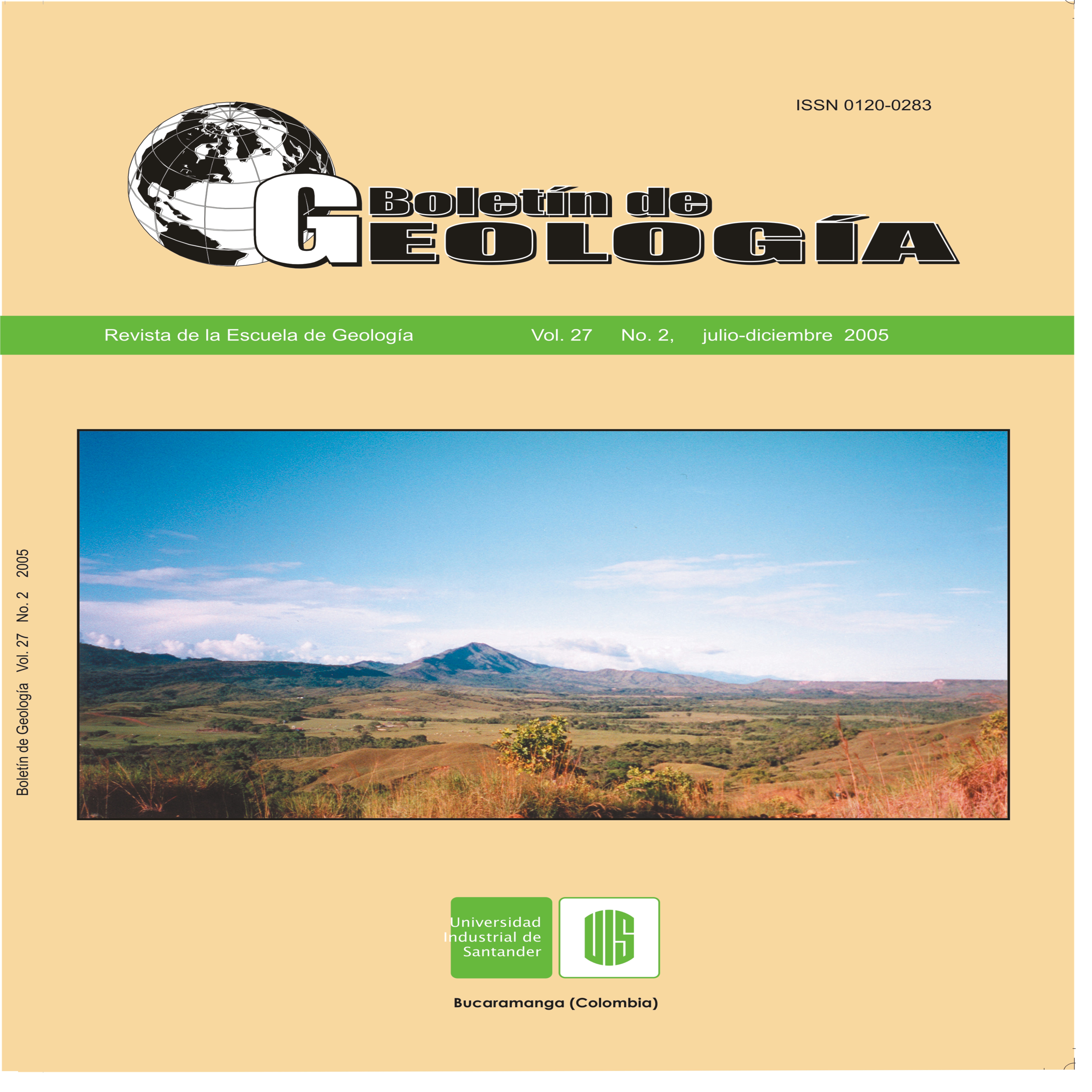MEDIUM-PRESSURE METAMORPHISM IN THE CENTRAL SANTANDER MASSIF, EASTERN CORDILLERA, COLOMBIAN ANDES
Cómo citar
Resumen
The Central Santander Massif exposes its metamorphic basement, which mainly consists of medium- to high-grade pelitic schists, paragneisses, migmatites and orthogneisses. For delineating its metamorphic evolution, we have examinated mineral assemblages, metamorphic reactions and P-T conditions of metamorphic rocks of this region. Metamorphism has occurred under conditions of high-temperature and medium-pressure (Barrovian type metamorphism), and three metamorphic zones were developed: staurolite-kyanite, sillimanite and migmatite zones. Pressure and temperatura conditions, estimated by TWQ program, are in the range of 5.0-9.5 kbar and 630-727oC. The P-T path of the metamorphic units is clockwise suggesting a collision model for this region of the Colombian Andes.
Keywords: Metamorphism; Santander Massif; Barrovian type; P-T path; collision
Descargas
Referencias
Bence, A., and Albee, A. (1968). Empirical correctionfactors for the electron microanalysis of silicates andoxides. Journal of Geology, Vol. 76, pp. 382-403.
Berman, R. (1997) Programm TWQ version 2.02. In:http://www.gis.nrcan.gc.ca/twq.html
Boinet, T., Bourgois, J., Bellon, H., and Toussaint, J.F.(1985). Age et repartition du magmatism premesozoiquedes Andes de Colombie. Comptes rendus hebdomadairesdes séaces de L’Académie des Sciences. Serie D: SciencesNaturalles, Vol. 300(II), pp. 445-450
Cardona, A. (2003). Correlacoes entre fragmentos doembasamento Pre-Mesozoico da terminacao setentrionaldos Andes Colombianos, com base em datos isotopicos egeocronologicos. Dissertacao de Mestrado, Universidadede Sao Paulo, Instituto de Geociencias, 149 pp
Castellanos, O.M. (2001). Chemical composition of therock-forming minerals in the Silgará formation and P-Tconditions in the Mutiscua area, Santander Massif,Eastern Cordillera, Colombia. Master Thesis, ShimaneUniversity, Matsue (Japan), 146pp
Castellanos, O.M., Ríos, C.A., and Takasu, A. (2004).Chemically sector-zoned garnets in the metapelitic rocksof the Silgará Formation in the central Santander Massif,Colombian Andes: occurrence and growth history.Boletín de Geología, Vol. 26(42), pp.9-18
Chinner, G.A. (1961). The origin of sillimanite in Glen Clova,Angus. Journal of Petrology, Vol. 2(3), pp. 312-323
Cordani, U.G., Cardona, A., Jiménez, D.M., and Liu, D.(2003). Did the Precambrian basement inliers of northernColombia play any role in Rodinia ́s formation?. MemoriasResumenes IX Congreso Colombiano de Geología,Medellín, pp. 34.
Dörr, W., Grösser, J., Rodriguez, G., and Kramm, U.(1995). Zircon U-Pb age of the Paramo Rico tonalite-granodiorite, Santander Massif (Cordillera Oriental,Colombia) and its geotectonic significance. Journal ofSouth American Earth Sciences, Vol. 8(2), pp. 187-194
García, C.A., y Ríos, C.A. (1997). Mineralogía yPetrografía de las Metamorfitas al Oeste de Pamplona(Norte de Santander), Colombia”. Memorias del XVICurso Internacional de Postgrado en Metalogenia. SesiónPonencias. Universidad Central del Ecuador (Quito), pp.77-93
García, C.A., y Castellanos, O.M. (1998). Petrografíade la Formación Silgará en la Cordillera Oriental,Colombia. X Congreso Latinoamericano de Geología,Buenos Aires, Argentina, Memorias, T.2, pp. 263-268
García, C.A., y Ríos, C.A. (1999). Metamorfismo ymetalogenia asociada del Macizo de Santander, CordilleraOriental, Colombia. Informe final Proyecto deInvestigación. Universidad Industrial de Santander-Colciencias, p. 191
García, C.A., y Campos, N.O. (2000). Composiciónquímica y mineralogía de las biotitas metamórficas delsector central del Macizo de Santander, Colombia. Boletínde Geología, Vol. 22 (37), pp. 18-27
Goldsmith, R., Marvin, R.F., and Mehnert, H.H. (1971).Radiometric ages in the Santander Massif, easternCordillera, Colombian Andes. U.S. Geological SurveyProfessional Paper, Vol. 750-D, pp. D41-D49
Gordon, T., Aranovich, L., and Fed’kin, V. (1994).Exploratory data analysis in thermobarometry: An examplefrom the Kisseynew sedimentary gneiss belt, Manitoba,Canada. American Mineralogist, Vol. 79, pp. 973-982
Holdaway, M.J. (1971). Stability of andalusite and thealuminum silicate phase diagrams. American Journal ofScience, Vol. 271, pp. 97-131
Inger, S., and Harris, N. (1992). Tectonothermal evolutionof the High Himalayan Crystalline Sequence, LangtangValley, northern Nepal. Journal of Metamorphic Geology,Vol. 10, pp. 439-452
Julivert, M. (1958). La morfoestructura de la zona demesas al SW de Bucaramanga. Boletín de Geología /Universidad Industrial de Santander (Colombia), Vol. 1,pp. 7-44.
Julivert, M. (1959). Geología de la vertiente W del Macizode Santander en el sector de Bucaramanga. Boletín deGeología/Universidad Industrial de Santander (Colombia),Vol. 3, pp. 15-34
Julivert, M. (1961a). Las estructuras del valle medio delMagdalena y su significación. Boletín de Geología/Universidad Industrial de Santander (Colombia), Vol. 6,pp. 33-52
Julivert, M. (1961b). Geología de la vertiente W de laCordillera Oriental en el sector de Bucaramanga. Boletínde Geología / Universidad Industrial de Santander(Colombia), Vol. 8, pp. 39-42.Julivert, M. (1963). Nuevas observaciones sobre laestratigrafía y tectónica del Cuaternario de los alrededoresde Bucaramanga. Boletín de Geología / UniversidadIndustrial de Santander (Colombia), Vol. 3, pp.15-34
Kretz, R. (1983). Symbols for rock-forming minerals.American Mineralogist, Vol. 68, pp. 277-279
